This document describes a study that explored advanced practice nurses' perceptions of their leadership capabilities. The study identified two main themes of leadership demonstrated by advanced practice nurses: patient-focused leadership and organization and system-focused leadership. Patient-focused leadership involves capabilities that directly impact patients and families, such as managing patient-centered care, coaching and educating, advocating, and initiating communication. Organization and system-focused leadership involves capabilities that directly impact nurses, healthcare providers, organizations, and the healthcare system, such as improving quality of care, enhancing nursing practice, communicating effectively, and facilitating collaboration. The study developed a model of advanced practice nurse leadership capabilities based on these themes to clearly articulate the nature and complexity of advanced practice nursing roles.
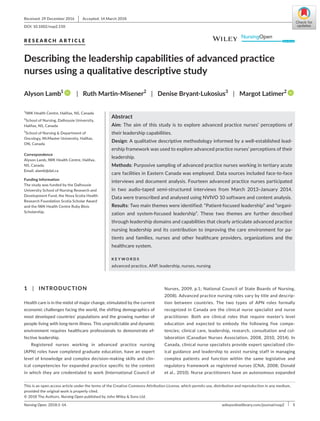


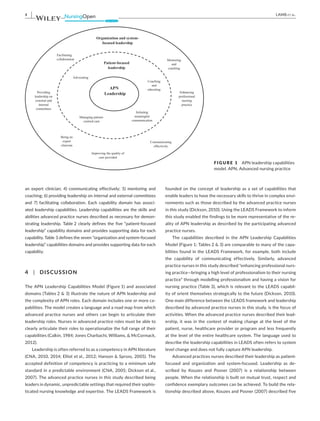





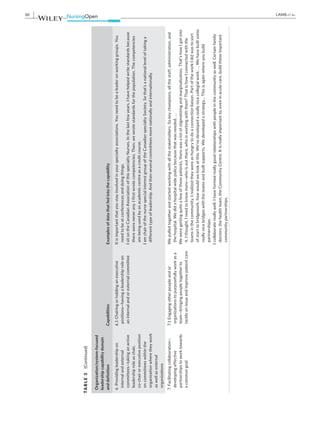

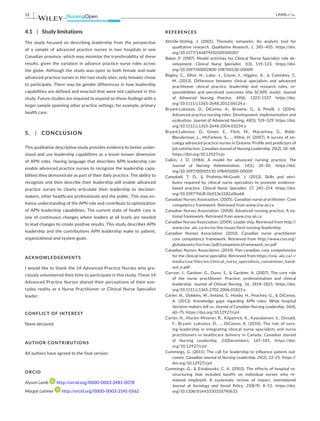
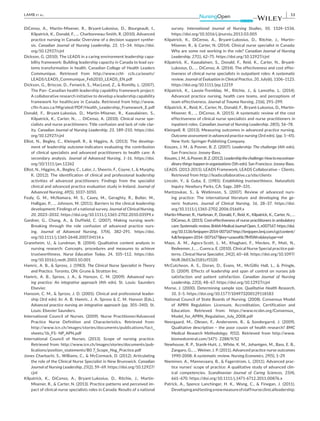
![14 | LAMB et al.
The clinical leadership survey. Journal of Nursing Management, 19,
449–460. https://doi.org/10.1111/j.1365- 2834.2011.01238.x
Pauly, B., Schreiber, R., MacDonald, M., Davidson, H., Crickmore, J., Moss,
L., … Hammond, C. (2004). Dancing to our own tune: Understandings
of advanced nursing practice in British Columbia. Canadian Journal of
Nursing Leadership, 17(2), 47–59. https://doi.org/10.12927/cjnl
QSR International Pty Ltd. (2012). NVivo (Version 10) [Computer software].
Burlington, MA: QSR International Pty Ltd.
Sandelowski,M.(1995).Samplesizeinqualitativeresearch.ResearchinNursing
Health, 18, 179–183. https://doi.org/10.1002/(ISSN)1098-240X
Sandelowski, M. (2000). Whatever happened to Qualitative Description?
Research in Nursing Health, 23, 334–340. https://doi.org/10.1002/
(ISSN)1098-240X
Sandelowski, M. (2010). What’s in a name? Qualitative description revis-
ited. Research in Nursing Health, 33, 77–84.
Schober, M., Affara, F. (2006). International council of nurse: Advanced
nursing practice. Oxford: Blackwell Publishing.
Scott, E. S., Miles, J. (2013). Advancing leadership capacity in nurs-
ing. Nursing Administration Quarterly, 37(1), 77–82. https://doi.
org/10.1097/NAQ.0b013e3182751998
van Soeren, M., Hurlock-Chorrstecki, C., Reevesm, S. (2011). The
role of nurse practitioners in hospital settings: Implications
for interprofessional practice. Journal of Interprofessional Care,
25, 245–251. https://doi.org/10.3109/13561820.2010.539305
Whitehead, D., Welch Dittman, P., McNulty, D. (2017). Leadership and
the advanced practice nurse, The future of a changing health-care envi-
ronment. Philadelphia, PA: F.A. Davis Company.
Wong, C. A., Cummings, G. G. (2007). The relationship between
nursing leadership and patient outcomes: As systematic re-
view. Journal of Nursing Management, 15, 508–521. https://doi.
org/10.1111/j.1365-2834.2007.00723.x
How to cite this article: Lamb A, Martin-Misener R, Bryant-
Lukosius D, Latimer M. Describing the leadership capabilities
of advanced practice nurses using a qualitative descriptive
study. Nursing Open. 2018;00:1–14. https://doi.org/10.1002/
nop2.150](https://image.slidesharecdn.com/lamb2018-240204164135-26f11515/85/lamb2018-pdf-14-320.jpg)